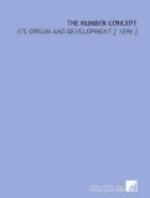In the selection of a base,—of a number from which he makes a fresh start, and to which he refers the next steps in his count,—the savage simply follows nature when he chooses 10, or perhaps 5 or 20. But it is a matter of the greatest interest to find that other numbers have, in exceptional cases, been used for this purpose. Two centuries ago the distinguished philosopher and mathematician, Leibnitz, proposed a binary system of numeration. The only symbols needed in such a system would be 0 and 1. The number which is now symbolized by the figure 2 would be represented by 10; while 3, 4, 5, 6, 7, 8, etc., would appear in the binary notation as 11, 100, 101, 110, 111, 1000, etc. The difficulty with such a system is that it rapidly grows cumbersome, requiring the use of so many figures for indicating any number. But Leibnitz found in the representation of all numbers by means of the two digits 0 and 1 a fitting symbolization of the creation out of chaos, or nothing, of the entire universe by the power of the Deity. In commemoration of this invention a medal was struck bearing on the obverse the words
Numero Deus impari gaudet,
and on the reverse,
Omnibus ex nihilo ducendis sufficit Unum.[166]
This curious system seems to have been regarded with the greatest affection by its inventor, who used every endeavour in his power to bring it to the notice of scholars and to urge its claims. But it appears to have been received with entire indifference, and to have been regarded merely as a mathematical curiosity.
Unknown to Leibnitz, however, a binary method of counting actually existed during that age; and it is only at the present time that it is becoming extinct. In Australia, the continent that is unique in its flora, its fauna, and its general topography, we find also this anomaly among methods of counting. The natives, who are to be classed among the lowest and the least intelligent of the aboriginal races of the world, have number systems of the most rudimentary nature, and evince a decided tendency to count by twos. This peculiarity, which was to some extent shared by the Tasmanians, the island tribes of the Torres Straits, and other aboriginal races of that region, has by some writers been regarded as peculiar to their part of the world; as though a binary number system were not to be found elsewhere. This attempt to make out of the rude and unusual method of counting which obtained among the Australians a racial characteristic is hardly justified by fuller investigation. Binary number systems, which are given in full on another page, are found in South America. Some of the Dravidian scales are binary;[167] and the marked preference, not infrequently observed among savage races, for counting by pairs, is in itself a sufficient refutation of this theory. Still it is an unquestionable fact that this binary tendency is more pronounced among the Australians than among any other extensive




